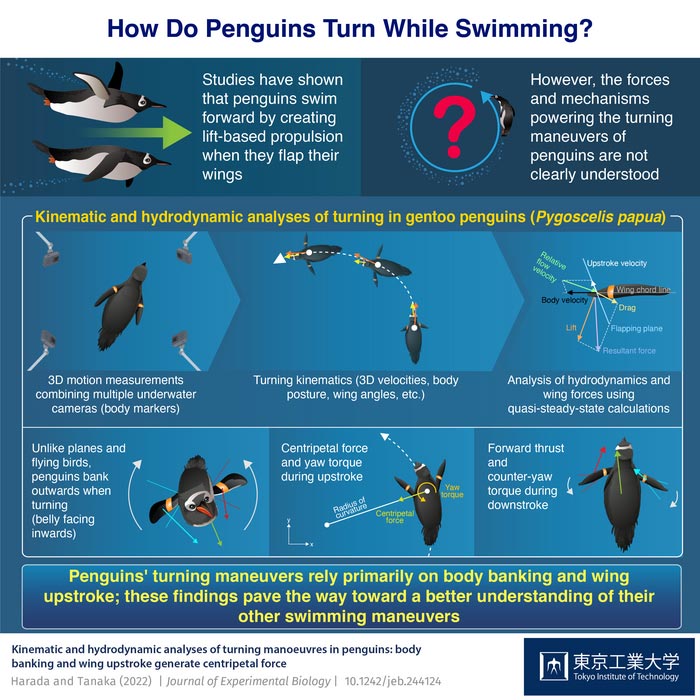Penguin physics…

Credit: Tokyo Tech
… understanding the mechanisms of underwater turning maneuvers in penguins.
Penguins constitute a fascinating family of flightless birds that, although somewhat clumsy on land, are extremely talented swimmers. Their incredible maneuverability in water has captivated biologists for decades, with the first hydrodynamic studies on their swimming dating back to the 1970s.
Although a rare few studies have clarified some of the physics behind penguins’ dexterity, most of them have focused on forward swimming rather than turning. While one may argue that existing studies on the turning mechanisms of flying birds could shed some light on this topic, water is 800 hundred times denser than air, and thus the turning mechanisms employed are presumably very different between these media.
In an effort to bridge this knowledge gap, a pair of Japanese scientists from Tokyo Institute of Technology (Tokyo Tech), including Associate Professor Hiroto Tanaka, recently conducted a study. The main goal of this work, which was published in Journal of Experimental Biology, was to gain a better understanding of the three dimensional (3D) kinematics and hydrodynamic forces that enable penguins to turn underwater.
The researchers recorded two sessions of gentoo penguins (Pygoscelis papua) free swimming in a large water tank at Nagasaki Penguin Aquarium, Japan, using a dozen or more underwater cameras. Then, thanks to a technique called 3D direct linear transformation, they were able to integrate data from all the footage and conduct detailed 3D motion analyses by tracking various points on the penguins’ bodies and wings.
Armed with these data, the researchers then established a mathematical 3D body model of the penguins. This model covered the orientation and angles of the body, the different positions and motions of the wings during each stroke, the associated kinematic parameters and hydrodynamic forces, and various turning metrics. Through statistical analyses and comparisons with the experimental data, the researchers validated the model and gained insight into the role of the wings and other body movements during turning.
The main findings of the study were related to how penguins generate centripetal force to assist their turns. They achieve this, in part, is by maintaining outward banking, which means that they tilt their bodies such that their belly faces inward. In powered turns—those in which the penguin flaps its wings—the majority of changes in direction occur during the upstroke, whereas the forward thrust occurs during the downstroke. In addition, it turns out that penguins flap their wings with a certain asymmetry during powered turns. “We found contralateral differences in wing motion; the wing on the inside of the turn becomes more elevated during the upstroke than the other,” explains Assoc. Prof. Tanaka, “Quasi-steady calculations of wing forces confirmed that this asymmetry in wing motion with the outward banking contributes to the generation of centripetal force during the upstroke. In the following downstroke, the inside wing generates thrust and counter yaw torque to brake the turning.”
Overall, these findings contribute to a greater understanding of how penguins turn when swimming, which is relevant from both biological and engineering standpoints. However, Assoc. Prof. Tanaka remarks that these findings bring but one piece to the puzzle: “The mechanisms of various other maneuvers in penguins, such as rapid acceleration, pitch up and down, and jumping out of the water, are still unknown. Our study serves as the basis for further understanding of more complex maneuvers.”
Let us hope future research helps fully clarify how penguins achieve their mesmerizing aquatic prowess!
Journal: Journal of Experimental Biology
DOI: 10.1242/jeb.244124
Method of Research: Experimental study
Subject of Research: Animals
Article Title: Kinematic and hydrodynamic analyses of turning manoeuvres in penguins: body banking and wing upstroke generate centripetal force
Article Publication Date: 22-Dec-2022
All latest news from the category: Life Sciences and Chemistry
Articles and reports from the Life Sciences and chemistry area deal with applied and basic research into modern biology, chemistry and human medicine.
Valuable information can be found on a range of life sciences fields including bacteriology, biochemistry, bionics, bioinformatics, biophysics, biotechnology, genetics, geobotany, human biology, marine biology, microbiology, molecular biology, cellular biology, zoology, bioinorganic chemistry, microchemistry and environmental chemistry.
Newest articles
Faster, more energy-efficient way to manufacture an industrially important chemical
Zirconium combined with silicon nitride enhances the conversion of propane — present in natural gas — needed to create in-demand plastic, polypropylene. Polypropylene is a common type of plastic found…

Energy planning in Ghana as a role model for the world
Improving the resilience of energy systems in the Global South. What criteria should we use to better plan for resilient energy systems? How do socio-economic, technical and climate change related…

Artificial blood vessels could improve heart bypass outcomes
Artificial blood vessels could improve heart bypass outcomes. 3D-printed blood vessels, which closely mimic the properties of human veins, could transform the treatment of cardiovascular diseases. Strong, flexible, gel-like tubes…




















